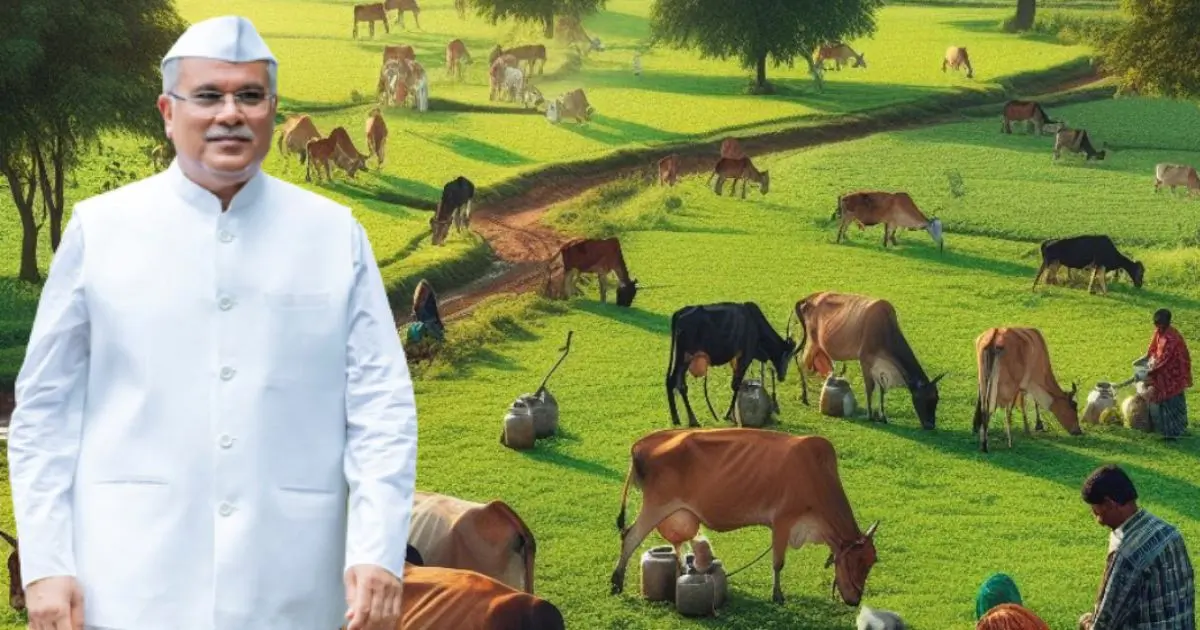The Chhattisgarh Godhan Nyay Yojana, introduced in 2020, serves as a compelling case study for other states in India to follow. This initiative, led by Chief Minister Bhupesh Baghel, demonstrates a well-executed scheme to support farmers and cattle rearers.
In this session, we will explore the key aspects of this case study and discuss how other states can learn from and adapt similar programs to empower their rural communities.
In 2020, the Chief Minister of Chhattisgarh, Bhupesh Baghel, initiated a groundbreaking scheme to provide much-needed support to the state’s farmers and cattle rearers.
Named the “Chhattisgarh Godhan Nyay Yojana,” this program is tailored to address the unique challenges faced by those involved in cow rearing and cattle herding in the region.
Page Index
What is the Chhattisgarh Godhan Nyay Yojana?
Launched on July 21, 2020, the Chhattisgarh Godhan Nyay Yojana is a pioneering initiative that primarily focuses on the welfare of farmers and cattle herders within the state.
The key aspect of this scheme involves the purchase of cow dung from any farmer who raises cows in Chhattisgarh. This not only provides farmers with an additional source of income but also promotes sustainable agricultural practices.
How to Apply for Chhattisgarh Godhan Nyay Yojana?
Participating in this scheme is straightforward, and eligible individuals can easily apply. To do so, applicants need to visit the official website dedicated to the scheme. The application process is designed to be user-friendly and can be completed using a mobile device or a computer.
Qualifications for Participation
To ensure a smooth and efficient implementation of the Chhattisgarh Godhan Nyay Yojana, the state government has laid out some essential qualifications for participants. These include:
- A valid bank account.
- Linking the bank account to the individual’s Aadhaar number.
This setup allows for the seamless transfer of funds to the beneficiaries through the Direct Benefit Transfer system, facilitated by Cooperative Banks.
The Government’s Objective
The Chhattisgarh state government has a clear vision for this scheme. It aims to not only provide much-needed financial support to cow-rearing farmers and cattle rearers but also to address the issue of abandoned animals when they cease to produce milk.
By doing so, the scheme contributes to reducing the problem of stray cattle roaming the streets, thus enhancing public safety and animal welfare.
Required Documents for Application
To complete the application process, interested individuals should be prepared with the following documents:
- Aadhar Card
- Domicile Certificate
- Mobile Number
- Bank Account Number
- Bank Passbook
- Income Certificate
- Voter ID Card
During the application, some crucial information will be collected from the applicant. It’s essential to ensure that all details provided are accurate and consistent, as any discrepancies may lead to the rejection of the application.
Boosting the Local Economy
By June 2023, Chief Minister Bhupesh Baghel’s government had disbursed a substantial sum of Rs 12.72 crore to the beneficiaries of the Chhattisgarh Godhan Nyay Yojana.
The data indicates that, in total, an impressive amount of Rs 488.67 crore has been paid to beneficiaries, marking a significant economic boost for farmers and cattle herders in the state.
Purchase Rate
The scheme operates in two distinct phases. In the first phase, a total of 2,240 cowsheds have been included under its ambit. In the second phase, cow dung is procured from cattle farmers, and this collected cow dung is used to produce organic food. The government purchases cow dung from cattle farmers at a competitive rate of Rs 2 per kilogram, providing them with a reliable source of income.
Case Study Overview
Chhattisgarh Godhan Nyay Yojana aims to uplift and support farmers and cattle rearers by purchasing cow dung and promoting sustainable agricultural practices. The key features of this program are:
- Purchase of Cow Dung: Under this scheme, the government purchases cow dung from any farmer who raises cows within the state. This not only provides farmers with an additional source of income but also encourages responsible waste management.
- Direct Benefit Transfer (DBT): Funds are transferred directly to the beneficiaries’ bank accounts, ensuring a streamlined process and transparency. To qualify, applicants must have a bank account linked to their Aadhaar number.
- Animal Welfare: The program addresses the issue of abandoned animals, ensuring that cattle farmers do not leave their animals wandering when they stop producing milk. This contributes to reducing the problem of stray cattle on the streets.
- Purchase Rate: Cow dung is procured from cattle farmers at a rate of Rs 2 per kilogram, offering a fair income to those involved.
Session Agenda for Other States
This session aims to guide other states in India to learn from the Chhattisgarh Godhan Nyay Yojana case study and consider implementing similar schemes to empower their own rural communities. The following agenda outlines key discussion points:
1. Understanding Local Needs: Before launching any program, it’s crucial to understand the specific needs of your state’s farmers and cattle rearers. Engage with stakeholders, conduct surveys, and gather insights to tailor the initiative to local requirements.
2. Designing a User-Friendly Application Process: The success of Chhattisgarh’s program is partly attributed to its straightforward application process. States should aim to create user-friendly online platforms accessible via mobile devices and computers. Ensure that the process is inclusive and easy for all beneficiaries to complete.
3. Financial Inclusion: Promote financial inclusion by linking the beneficiaries’ bank accounts to their UID (Aadhar) numbers. This ensures efficient fund transfer and increases transparency.
4. Animal Welfare Measures: Address the issue of abandoned animals responsibly. By providing incentives to cattle farmers and creating a system that ensures the welfare of animals, states can effectively reduce the problem of stray cattle.
5. Promoting Sustainable Practices: Encourage responsible waste management and sustainability. States should explore how waste materials, such as cow dung, can be repurposed for organic farming or other environmentally friendly practices.
6. Funding and Economic Impact: Allocate funds to support the program’s implementation and monitor its economic impact. Analyze the data and assess the scheme’s effectiveness in uplifting the local economy.
7. Public Awareness and Outreach: Educate the rural community about the program through effective outreach campaigns. This will ensure that all eligible individuals are aware of the benefits and how to apply.
The Chhattisgarh Godhan Nyay Yojana case study serves as a valuable model for other states in India. By implementing similar initiatives, states can empower their farmers and cattle rearers, support sustainable agricultural practices, and contribute to the overall economic development of their regions. Learning from this case study, they can design and execute programs that best suit their specific needs and circumstances.
In summary, the Chhattisgarh Godhan Nyay Yojana is a shining example of a government scheme designed to uplift rural communities, empower farmers and cattle rearers, and promote sustainable agricultural practices.
This comprehensive initiative not only supports the local economy but also reflects the government’s commitment to ensuring the welfare and prosperity of its citizens.


